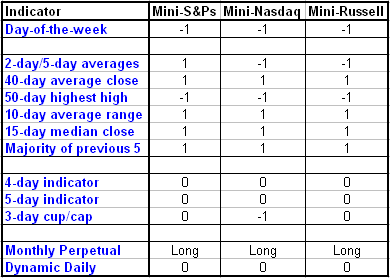Not long ago, we looked at a concept of dividing a trading day into three equal parts, or as near as possible to that. In other words, you would be trading on 135-minute bars in all the financials we look at. (The 405-minute daily index time frame divides exactly, while the 400-minute currencies round to that number.)
Our previous concept was for trading the last third of the day if the first two bars closed on the same side of the daily open. If the closes were both higher, you'd be a buyer at the start of the last third of the day, and vice versa if they were lower.
Today, we'll give you a way to enter as the first third is ending. In theory, it follows the standard practice of buying as the market rallies off an open at a certain percentage of previous range averages on a stop. This time, though, we're going to add a time qualifier. If the move is dramatic early on, that portends a continued move into the close.
So much for the theoretical: Here's the actual skinny.
When it is 135 minutes into the day's trading session (that is 10:45 a.m. Central Time in the indexes or 9:35 a.m. Central Time in the other financials) and the close minus the daily open is already greater or equal to the last three day's daily average, then buy at the market and exit on close. Vice versa if the close is less than the daily open and the difference is greater than the average three-day range. Figure 1 shows the results.

The Biases for June 6
The monthly signal gets bearish on Tuesday. Despite core day-of-the-week short signals in all three indexes, (Friday = Monday), the other dailies negate them. The monthly has one more bullish bias day, and that's the uncontested signal for June 6.
Hold longs in the mini S&Ps and Russell. Flip from short to long in the Nasdaq.
The bottom two rows determine the signal. Dynamic Day One trumps everything‚Ä"you always follow it. When it's neutral, the Monthly Perpetual provides the direction. Click here for a more in-depth explanation of the rules.

DISCLAIMER: It should not be assumed that the methods, techniques, or indicators presented on in this column will be profitable or that they will not result in losses. Past results are not necessarily indicative of future results. Examples presented on this column are for educational purposes only. These set-ups are not solicitations of any order to buy or sell. The author, Tiger Shark Publishing LLC, and all affiliates assume no responsibility for your trading results. There is a high degree of risk in trading.
Art Collins is the author of Market Beaters, a collection of interviews with renowned mechanical traders. He is currently working on a second volume. E-mail Art at artcollins@ameritech.net.